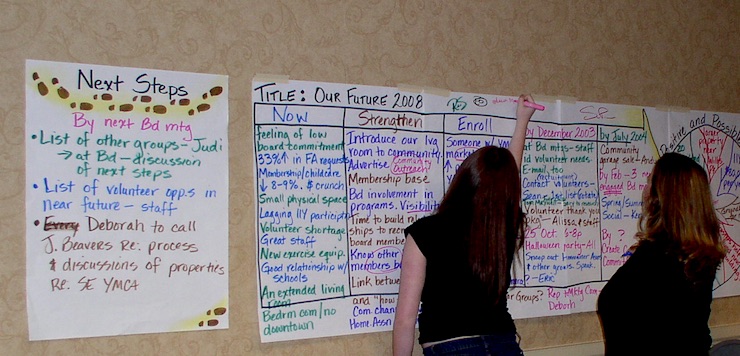The Power of Volunteers
Effective and Sustainable Volunteer Programs from Ruth E. Nicholson, CPF – the founder of Nicholson Facilitation & Associates, LLC – A Youth Sports Services company that helps organizations operate better at the board and operations levels … the “off-field team” that needs to work well together to support players and coaches on the field.

Good volunteer program design decreases administrative costs, engages club members, increases program support, shares the workload, and improves support for coaches so they can devote more time to our players.
Volunteers are not free.
The average value of a volunteer hour in the United States in 2014 was $23.07 USD. This figure – which is also available on a state-by-state basis – can be used in annual reports, grant proposals, and financial statements to support your organization’s work.
The Five Steps to building a successful volunteer program are knowing what you need, inviting participation, preparation and training, doing the work, and volunteer appreciation.
1. Know What You Need
The first step in building an efficient and sustainable volunteer program is understanding how your organization is put together. From that foundation, you can identify what specific volunteer jobs need to be filled.
It is important to develop a written job description for all your volunteer jobs, regardless of size or complexity. The four (4) basic components of a job description are skills and abilities, tasks and time, communications and reporting, and supplies and equipment. Outline the skills needed for each job, both knowledge and physical abilities. Then, describe the responsibilities of the position, including the specific tasks and activities and how many hours it will take to complete them. The job description should also clarify who is the supervisor or coordinator for the work and who else is involved in the project. Finally, identify what supplies and equipment are needed to do the work and who provides them.

2. If You Don’t Ask, They Can’t Say “YES!”
When you approach people to invite them to volunteer, be specific about the help you are requesting. Use the job description to both inform the potential volunteer and make yourself and your organization look good and well-organized. Describe both the benefit of the volunteer job to the organization and to the volunteer.
Remember to make the volunteer job both meaningful and manageable. If a volunteer job requires more than an average of 10 hours a week, you are setting up a situation for volunteer burnout, turnover, and potential loss of institutional memory.
3. Preparation and Training
This step involves both ensuring that your volunteers have the knowledge to do the job, as well as the right supplies and equipment. Let your volunteers in on your organization’s institutional knowledge and “the way we do things here”. Make sure they have clear instructions about the job they will be doing, which may include written instructions with diagrams or pictures, oral explanations, or a physical demonstration of how to accomplish a task. Also let them know who to contact if they have questions or need help.
Your written job description should contain a list of supplies and equipment needed to do the work. Let your volunteers know who is providing the supplies, including how they are purchased and delivered to the job site. In addition, clearly communicate what happens to any leftover supplies after the job is completed.

4. Get Stuff Done!
After all of the planning, it is time to do the work! This step is all about supporting your volunteers doing their jobs. Know who is going to actively support and supervise the volunteers as the work progresses. Set the organizational priorities and have a back-up plan in the event something goes amiss, such as a volunteer no-show or a lack of supplies.
Also, incorporate volunteer feedback and suggestions into the job. Your volunteers may identify different ways to get things done and have ideas about how to improve the work in the future. Listening to recommendations and incorporating new approaches will more deeply engage your volunteers and build their loyalty to your organization. Volunteer engagement is often more important than job perfection.
5. Say “THANK YOU!”
A key component to retaining volunteers is remembering to thank them for their time and contributions. Consider expressing your gratitude in ways that align with how your volunteers see themselves and their talents. Those who see themselves as technically skilled will appreciate being recognized for their expertise. Others who are caregivers and peace makers will respond well to your gratitude for their looking out for everyone on the team. Other volunteers are those who are well- connected with people in the community. These folks will appreciate being thanked for their knowledge of who to call to engage resources and how to get things done.
In the End
The real secret to building a successful volunteer program is in the preparation. Consider how much time a coach spends preparing a team for competitions. There are considerably more hours of designing and conducting training sessions than there are hours in actual games. How much time does your organization spend preparing for success in your volunteer programs?
The recipe for success for a successful volunteer program is three (3) parts preparation (knowing you need, inviting participation, preparation and training) plus one (1) part doing the volunteer work plus one (1) part gratitude.
Who is Ruth?
Ruth Nicholson is the Principal of Nicholson Facilitation & Associates, a woman-owned consultancy offering services in organizational development, facilitation, conflict resolution, training, and professional assessment. The firm’s Youth Sports Services provide training and custom consulting to strengthen club operations and enhance coaching effectiveness.
Nicholson is an internationally certified facilitator and instructor who has worked in soccer governance and administration for over 25 years. She offers a portfolio in soccer operations that includes strategic planning, volunteer programs, board operations, club administration, and tournament, camp, and stadium management.
Nicholson has also worked as a coach, referee, and referee assigner. Ruth is a contributing specialist in the Changing the Game Project’s Coaching Mastery course, as well as an invited speaker at the US Youth Soccer Leadership Development Symposium, National Soccer Coaches Association of America (NSCAA) Convention, and US Youth Soccer Workshop. Check out her speaking schedule below:
Thursday, January 14th– NSCAA Convention
• From Turmoil to Teammates: Conflict Resolution for Coaches, Parents, and Administrators. 9:30–10:30 am, Room CC 341-42. This workshop is part of the NSCAA Management of the Game Special Topics Diploma
• Improving Coach Performance Through the Development of an In-House Coaching Education Program. 2:15-3:15 pm, Room CC 310
Friday, January 15 – US Youth Soccer Workshop
• Advancing Too Soon? When’s Too Soon? (Ability vs. Maturation vs. Mindset). 9:00–10:00 am, Room CC 323. Presented with
- Chris Panayiotou, Rush Soccer National Developmental Director of Coaching and Technical Director, Virginia Rush Soccer Club
- Steve Davis, Technical Director and Director of Coaching for Seniors, New York Rush
- Chris Hamblin, Director of Coaching, New England Football Club
• Secrets to Making Your Volunteer Program Effective and Sustainable. 2:30–3:30 pm, Room CC 319
Friday, January 16 – US Youth Soccer Workshop
• Improving Your Off-Field Team: Integrating Club Operations to Support Players and Coaches. 11:00am-12noon, Room CC 316-17
• Women in Soccer. (An interactive goal-setting and action planning workshop). With Carrie Taylor. 2:15-3:15pm, Room 321







